mysql on os x 10.6 is located in /usr/local/mysql/bin/mysql
I get command not found when I type mysql --version in the terminal. Is this because the socket path is wrong? if so how do I fix it?
thanks
mysql on os x 10.6 is located in /usr/local/mysql/bin/mysql
I get command not found when I type mysql --version in the terminal. Is this because the socket path is wrong? if so how do I fix it?
thanks
adding this code to my .profile worked for me: :/usr/local/mysql/bin
Thanks.
P.S This .profile is located in your user/ path. Its a hidden file so you will have to get to it either by a command in Terminal or using an html editor.
I think this is the more simpler approach:
Switching to SQL mode... Commands end with ;
Go forth and do great things! :)
I've tried all the solutions from the answers but couldn't get
mysqlcommand to work from the terminal, always getting the messageThe solution is to change the .bash_profile, and add the mysql path to .bash_profile
To do so follow these steps: 1. Open a new Terminal window or make sure you are in the home directory 2. Open .bash_profile using
3. Add the following command to add the mysql path
4. Press Ctrl+X, then press y and press enter.
The following is how my .bash_profile looks like
Just do the following in your terminal:
echo $PATHIf your given path is not in that string, you have to add it like this:
export PATH=$PATH:/usr/local/orexport PATH=$PATH:/usr/local/mysql/binOn OSX 10.11, you can
sudo nano /etc/pathsand add the path(s) you want here, one per line. Way simpler than figuring which of~/.bashrc,/etc/profile, '~/.bash_profile` etc... you should add to. Besides, why export and append $PATH to itself when you can just go and modify PATH directly...?I'm using OS X 10.10, open the shell, type
it works temporary.if you use Command+T to open a new tab ,mysql command will not work anymore.
We need to create a .bash_profile file to make it work each time you open a new tab.
add the following line to the file.
Save the file, then open a new shell tab, it works like a charm..
by the way, why not try https://github.com/dbcli/mycli
it's a tool way better than the mysqlcli.. A command line client for MySQL that can do auto-completion and syntax highlighting